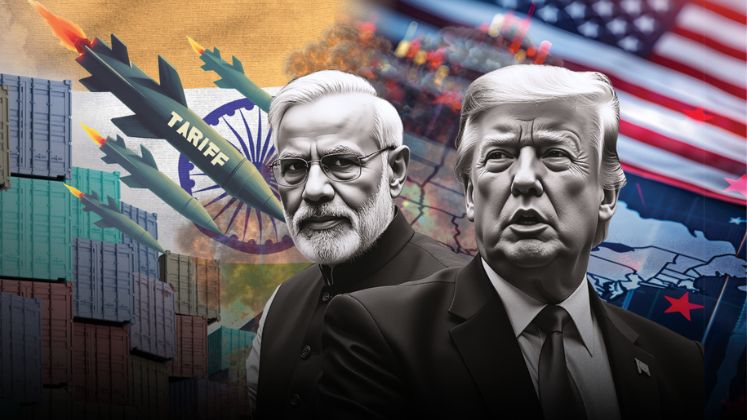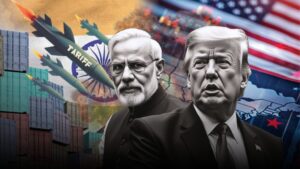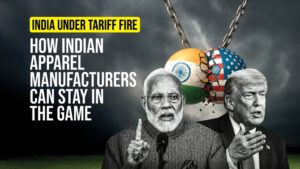Every industry faces moments that put its true character to test. For India’s readymade garment exporters, that moment has arrived. The United States has doubled tariffs on Indian apparel to 50% (63.9% on knitted apparel and 62.3% on woven apparel). In comparison, our rivals, Bangladesh and Vietnam face just a 20% tariff; Cambodia, Indonesia and Pakistan are at 19%; Turkey at 15%; and even China is at 30%. The maths is brutal.
This is not just another trade skirmish, it’s an economic punch to the gut. We’re talking about a sector that feeds millions, earns billions in foreign exchange and has been the cornerstone of India’s global manufacturing reputation. The blow is real and the clock is ticking.
For decades, the US has been our biggest and most demanding customer. Its market not only takes a large share of our output, but also shapes how we design, how we produce and how we plan capacity. Now, almost overnight, that equation has changed. From vertically integrated exporters to the mid-sized operators, every player is feeling the squeeze. Orders are being put on hold. Contracts are being rewritten. Some buyers want manufacturers to absorb the cost, others hint at moving their business to cheaper shores. Non-branded buyers are already packing their bags. The branded ones may stay for our compliance standards and reliability, but even they warn, there will be pain.
Right now, about one-third of India’s garment exports, worth US $ 5.33 billion in 2024-25, go to the US. India holds a 6.1% share in America’s US $ 85 billion apparel import market. Losing this business could directly affect around 700,000 workers and indirectly impact another 1.5 million workers in areas that serve the US market.
And yet, if there’s one thing history tells us, it’s that our industry knows how to survive a storm. We’ve weathered post-quota shocks, global recessions and a pandemic that shut the world down. This tariff hit isn’t just a setback, it’s a reset.
TARIFFS HALT ORDERS AND PUSH BUYERS AWAY
India’s apparel exports to the US comprise approximately 80% basic/ core products and 20% value-added products. Industry experts are making it very clear about how serious the impact will be. For example, Japanese brokerage firm Nomura said in a note that the steep 50% tariff is like a ‘trade embargo’ and will cause exports of affected products to stop suddenly. Because many industries like textiles, gems and jewellery have low profit margins and add less value, smaller companies may struggle to keep operating and compete.
One of the industry’s largest players, Gokaldas Exports, highlighted the challenges coming from the revised US tariffs. The company reported its highest-ever revenue of Rs. 3,917 crore (US $ 458.77 million) in FY ’25. “On-demand front, apparel imports in the first five months of the calendar year across the US, EU and UK increased by 7%, 12% and 10% respectively as brands have rationalised their inventory-to-sales ratio levels. The recently announced revised reciprocal tariff by the US on India is expected to pose a challenge in the second half of this financial year, as most of our order bookings for the next quarter are already closed,” highlighted Siva Ganapathi, MD, Gokaldas Exports.

“On-demand front, apparel imports in the first five months of the calendar year across the US, EU and UK increased by 7%, 12% and 10% respectively as brands have rationalised their inventory-to-sales ratio levels. The recently announced revised reciprocal tariff by the US on India is expected to pose a challenge in the second half of this financial year, as most of our order bookings for the next quarter are already closed.” Siva Ganapathi, MD, Gokaldas Exports
Similarly, Pallab Banerjee, MD, Pearl Global Industries, which reported a revenue of Rs. 4,506 crore (US $ 525) in FY ’25, noted, “The increase from 25% to 50% US tariff on India has made it difficult for global retailers to continue sourcing from India this season.” He added that many retailers now want to quickly move their business out of India to other countries.

Likewise, Mithileshwar Thakur, Secretary General, AEPC, pointed out that, “Major US retailers such as Walmart, Amazon, Target and Gap Inc., have paused or halted orders, with exporters receiving written instructions to suspend shipments until further notice.”
He further mentioned that buyers are unwilling to share the increased costs, which are estimated to rise by 30-35%, and are pressurising exporters to absorb the full burden. Indian exporters are not at all in a position to absorb such a steep rise in tariff. This situation is prompting diversion of orders to Bangladesh and Vietnam.
Tirupur, known as the crown jewel of India’s apparel manufacturing and home to 5,000 MSMEs including 15 vertically integrated companies, is also going through a difficult time. The cluster generates revenue of Rs. 45,000 crore (US $ 5.13 billion), with the US accounting for Rs. 12,000 crore (US $ 1.37 billion) or 30% of the total.
“Brands are willing to accept the goods that have already been shipped, but the rest of the orders have been put on hold. We expect 50% of business to the US, worth about Rs. 6,000 crore (US $ 684 million), to be impacted,” said K M Subramanian, President, Tirupur Exporters Association (TEA) and Founder, KM Knitwear, a vertically integrated garment manufacturer.

Some manufacturers said that when the tariff was 25%, brands managed costs by ‘de-specing’, reducing product features to keep prices stable, similar to shrinkflation. But with the tariff now at 50%, these measures aren’t enough.
| “Brands are willing to accept the goods that have already shipped, but the rest of the orders have been put on hold. We expect 50% of business to the US, worth about Rs. 6,000 crore, to be impacted.” K M Subramanian, President, TEA and Founder, KM Knitwear |
“Earlier, when the tariff was 25%, brands were willing to share the extra cost with us. But now, they are not coming back and have put orders on hold. We already have October-November bookings in production, but it’s unclear how these will be handled under the new tariffs. If new orders don’t come, the gap will be another big challenge,” said Sanjeev Menon, VP – Business Development, Best Corporation Pvt. Ltd. The Tirupur-based manufacturer has an annual capacity of 144 million pieces, including output from its factory in Kenya and an annual turnover of US $ 125 million.
| “Pearl Global had been working over the past few years to reduce its dependence on the US. It is pertinent to note that US revenue from Indian entity in FY ’24-25 stands at 16-18% of group revenue and profit from the same business is between 4-5% of the group’s profit. Last year, we had more than 60% of business share from USA, this year, due to growth of other markets, this trend is just above 50%.” Pallab Banerjee, MD, Pearl Global Industries |
“We have already made the goods and are ready to ship, but buyers have asked us to hold shipments because of uncertain situation. This hesitation is not just about the goods we have produced, but also about new orders we discussed with them last month when we were in the US,” said Ziaul Alikhan, Marketing Manager, Aathava Garments India Pvt. Ltd. The Coimbatore-based manufacturer produces about 8.4 million pieces per year, with 60% of this going to the US market, mainly through Walmart, their major client.
He added, “Buyers expect us to share at least 15% of the tariff cost, but we cannot do that because the prices we have are already very competitive.”
Echoing these sentiments, Amrith Govindan Kutty, Senior GM (Marketing and Merchandising), Sakthi Infra Tex Pvt. Ltd., a vertically integrated manufacturer based in Perundurai, Tamil Nadu, with an annual production capacity of 90 million pieces —70-75% of which are exported to the US—said, “Since the tariff was announced, our US buyers have not placed any new orders.”
OVERSEAS UNITS TO KEEP PRODUCTION MOVING
While the damage is real, manufacturers are doing everything they can within their capacity to weather this storm.
Those with manufacturing units abroad are in a better position to handle this situation. The strategy is to shift US-bound production to overseas facilities while moving some of the production from those countries back to India.
For example, Gokaldas Exports acquired Dubai’s Atraco Group, which operates four factories in Kenya and one in Ethiopia, producing about 40 million garments a year, nearly equal to Gokaldas’ own capacity. These units source raw materials from China, Indonesia, India, Pakistan, Taiwan and the UAE. Kenya and Ethiopia face just a 10% tariff, one of the lowest globally.
Gokaldas Exports also runs a Bangladesh facility through its subsidiary, Gokaldas Images Pvt. Ltd., making innerwear, loungewear, suits, blazers and outerwear.
“Over the last few years, we have tried to de-risk our business model by expanding our product range and building manufacturing facilities across continents, in India and Africa and have focused on agility to be able to quickly add production capacity in any location,” said Siva Ganapathi.
He added that in the near term, the company intends to navigate these challenges by focusing on cost optimisation and better productivity gains across the group. Gokaldas has approved a draft scheme to merge BRFL Textiles Pvt. Ltd. (BTPL) with itself. The merger will integrate BTPL’s large fabric manufacturing capacity into Gokaldas’ operations, creating a vertically integrated business with operational and financial efficiencies.
For the uninitiated, BTPL manufactures a wide range of fabrics including cotton, linen, Giza cotton, viscose, polyester, Tencel, modal, Lycra and their blends.
| “Major US retailers such as Walmart, Amazon, Target and Gap Inc., have paused or halted orders, with exporters receiving written instructions to suspend shipments until further notice.” Mithileshwar Thakur Secretary General, AEPC |
Likewise, Pallab Banerjee mentioned that, “The increased tariff has triggered an immediate order shift, with buyers pushing for production to be relocated to alternative manufacturing hubs like Bangladesh, Vietnam, Indonesia and Guatemala where Pearl Global already has operational capacity.” Guatemala, like Kenya and Ethiopia, enjoys just a 10% tariff.
Pearl Global’s Bangladesh units employ over 10,000 people and produce 40 million pieces annually across knitted and woven categories, with facilities for denim dry and wet processing and multiple sustainability certifications. The Vietnam facility has 21 production lines and makes outerwear and jackets. The Indonesia plant manufactures women’s professionalwear, performancewear, activewear, woven tops and dresses, sleepwear and loungewear. The Guatemala factory produces knit products for all age groups, with an annual capacity of 5 million garments, soon to expand to 10 million.
“The only option we have right now is to move some production to our factory in Kenya. Those manufacturing only in India will surely get stuck in this situation. In the short term, and even as part of a long-term plan, companies need to look at alternatives, such as targeting European buyers, to reduce the impact,” said Sanjeev Menon from Best Corporation. Their Kenya facility makes innerwear and T-shirts, with an annual capacity of 30 million pieces.
Many other manufacturers with facilities outside the country have begun exploring how best to use them to mitigate the impact of tariffs.
For example, Alok Industries, one of India’s largest vertically integrated textile companies, has a presence in the Czech Republic through its acquisition of Mileta, which makes premium yarn-dyed shirting, handkerchiefs and table linen. Raymond operates a garment manufacturing facility in Ethiopia at the Hawassa Industrial Park through its subsidiary Silver Spark Apparel Ethiopia PLC, producing suits and other garments for export to the US and European markets.
Jay Jay Mills Group, a multinational manufacturer of baby garments, produces over a million garments a day from 10 locations in India, Sri Lanka, Bangladesh and Ethiopia.
Modelama Exports, a manufacturer and exporter of woven garments, including outerwear, ladies’ tops, dresses, kidswear, men’s shirts, scarves, ponchos, trousers and jackets, also runs two manufacturing units in Indonesia.
| Smaller exporters and MSMEs may struggle with reworking production schedules, negotiating raw material costs or shifting manufacturing to other geographies, given their smaller scale and lower bargaining power. Cash flow management will become even more critical as delayed payments or cancelled orders can severely impact day-to-day operations. Rahul Mehta, Chief Mentor, CMAI |

INDIA, A RETAIL GOLDMINE FOR US RETAILERS
Experts point out that not everything is doom and gloom. Many big US retailers have a strong retail presence in India such as Nike, Levi’s, Tommy Hilfiger and Walmart (through Flipkart). For them, India is not just a production hub; it is also a major retail market.
This is important because under India’s FDI rules, foreign single-brand retailers with 100% ownership must source at least 30% of what they sell in India from within the country. This sourcing rule is averaged over the first five years and then becomes an annual requirement. Therefore, even if US-bound exports slow down because of tariffs, these brands will still need Indian manufacturing for their local stores.
For example, Levi’s has over 400 stores in India, Gap has 51, American Eagle Outfitters has 17 and Nike has 94. Walmart has a big stake too, owning 77% of Flipkart, India’s leading e-commerce giant, which gives it a massive online retail presence.
Instead of walking away from India, for their US markets, most global retailers might shift sourcing to countries with lower tariffs. But for India’s booming retail market and nearby regions like the Middle East, Africa, Southeast Asia and Oceania, India could become an even more important sourcing hub. Its location, trade deals like the India– UAE CEPA and cultural links with neighbouring regions make it a natural choice for regional supply.
“Manufacturers are exploring new markets, considering joint ventures overseas and examining the feasibility of setting up facilities outside India. They are also focusing more on R&D and technology, improving the quality of their offerings, driving innovation and upgrading the skill sets of their workforce,” said Chandrima Chatterjee, Secretary General, CITI. However, experts also pointed out that smaller exporters will face challenges.

“Operationally, they may struggle with reworking production schedules, negotiating raw material costs or shifting manufacturing to other geographies, given their smaller scale and lower bargaining power. Cash flow management will become even more critical as delayed payments or cancelled orders can severely impact day-to-day operations,” said Rahul Mehta, Chief Mentor, CMAI.
INDIA’S EXPORT DIVERSIFICATION DRIVE
Rather than viewing the current tariff hike as a crippling setback, Indian manufacturers are treating it as a catalyst to widen their global footprint.
“India will continue to grow by tapping into new and advantageous partnerships like the UK FTA and will focus on other existing FTA markets of Japan and Australia until the US tariff issue is resolved. We believe such re-calibrations should help in retaining the customer wallet share and maintaining the profitability,” stressed Pallab.
He also highlighted that Pearl Global had been working over the past few years to reduce its dependence on the US. It is pertinent to note that US revenue from Indian entity in FY ’24- 25 stands at 16-18% of group revenue and profit from the same business is between 4-5% of the group’s profit.
“While this may lead to short-term volatility, long-term realignment is already underway. The goal is to stay agile amidst geopolitical uncertainty,” added Pallab.
Siva Ganapathi also highlighted that the recently signed India–UK trade deal gives India a 12% duty advantage over China and puts it on equal footing with Bangladesh.
With the India-UK FTA completed and the EU deal expected to be signed by year-end, Indian manufacturers are focusing on tapping EU retailers to offset losses from the US.
30%Under India’s FDI rules, foreign single-brand retailers with 100% ownership must source at least 30% of what they sell in India from within the country. |
For example, China and Bangladesh are the biggest production hubs for brands like H&M, but Indian manufacturers have growing opportunities. Zara’s global supply chain includes 12 Indian suppliers, though most of its production is in Spain, Portugal, Morocco and Türkiye. Decathlon ranks India as its fourth-largest sourcing country and plans to increase local sourcing from 8% to 15% by 2030. Other brands with significant Indian suppliers include Mango, ASOS, M&S, Primark, Next and Boohoo. Indian manufacturers can further increase their share of the sourcing pie with these brands.
In 2024, Bangladesh’s RMG exports to the EU reached US $ 19.37 billion or 50.34% of its total RMG exports, while that of India stood at just US $ 4.52 billion, highlighting the vast untapped market potential.
India is also negotiating FTAs with New Zealand, Oman, Peru, Israel and the Gulf Cooperation Council (GCC) countries.
Emerging markets such as Africa, Latin America and West Asia are fast climbing the priority list for Indian exporters. These regions offer growing middle-class population, rising demand for affordable fashion and relatively low import barriers. Countries like Brazil, Mexico, South Africa, Saudi Arabia and Egypt are emerging as potential high-growth destinations.
Exporters are also watching for trade opportunities in Japan and South Korea.
| “Manufacturers are exploring new markets, considering joint ventures overseas and examining the feasibility of setting up facilities outside India. They are also focusing more on R&D and technology, improving the quality of their offerings, driving innovation and upgrading the skill sets of their workforce.” – Chandrima Chatterjee Secretary General, CITI |
Another strategy for manufacturers is to tap India’s US $ 120 billion market by creating dedicated product lines for local buyers.
“Right now, the domestic market in India is doing very well. Brands like Zudio buy large quantities of goods almost as much as what we export,” highlighted Ziaul Alikhan from Aathava Garments.
“In the short term, India’s large domestic market can help cushion the impact. The government could take more steps to boost local demand, so factories get more orders from within the country,” said Sanjeev Menon from Best Corporation.
In fact the government has already taken some key initiatives to safeguard the exporters’ interest. For example, India plans to counter the United States’ 50% tariffs on textiles through outreach programmes in 40 countries. These 40 countries include Australia, Belgium, Canada, France, Germany, Italy, Japan, Mexico, Poland, Russia, Spain, South Korea, Turkiye, the Netherlands, the United Arab Emirates and the UK.
The government is also preparing a support package worth about Rs. 25,000 crore under the Export Promotion Mission (EPM). This was announced in the Union Budget 2025-26. It will support Indian exporters for six years, from 2025 to 2031.
In addition, the import duty exemption for cotton has been extended by three months till December 31.
Despite the tariff challenges, industry insiders agree that India’s garment sector is ready not just to survive, but to innovate, diversify and come out stronger on the global stage.
















